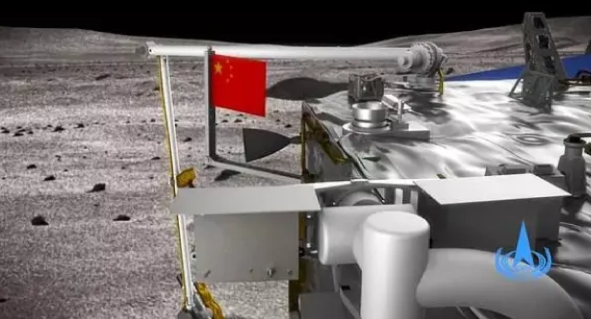Headline
BREAKING: China Mounts Its Flag On The Moon

After five decades, America first planted its colours on the lunar surface, China has flown its flag on the moon in a symbolic display of its intentions to compete with the US in space.
The flag was attached to Beijing’s spacecraft Chang’e-5 which is making its way back to Earth with the first lunar samples in decades after taking off from the moon on Thursday.
Beijing’s space authority released the picture of the fabric flag, weighing 0.4 ounces, holding still on the windless lunar surface and evoking memories of the Stars and Stripes which were once the crowning symbol of US supremacy in the space race.
While flags were painted on Chinese spacecraft in two earlier missions, raising one on the moon is a feat which only the Apollo missions have achieved before – making the lunar surface the latest flashpoint in China’s growing rivalry with America.
The Chang’e-5 spacecraft, named after the mythical Chinese moon goddess, left the moon at 3pm GMT on Thursday in what the space agency said was China’s first successful take-off from an extraterrestrial body.
It is bringing back lunar rocks and soil in the first mission to retrieve samples from the moon since the Soviet Union’s Luna 24 project in 1976.

A CGI image shows how the flag was attached to the Chang’e spacecraft, which became the first since America’s Apollo missions to plant a national flag on the lunar surface 1969: Buzz Aldrin stands by the Stars and Stripes after Apollo 11 landed on the moon, symbolising America’s victory in the space race Attached to the Chang’e-5 spacecraft, the flag was displayed before the ascender separated from the lander and blasted off into the lunar orbit yesterday, a statement said.

The lander vehicle ‘unfolded the five-star red national flag, a genuine one made from fabrics, marking a first in the country’s aerospace history’, state media said.
Two previous two lunar missions, Chang’e-3 and Chang’e-4, carried the emblem in the form of the crafts’ coatings – but neither flag was raised above the surface. Six American flags were placed on the Earth’s only natural satellite by Apollo astronauts between 1969 and 1972, starting with Neil Armstrong and Buzz Aldrin who made the historic first landing 51 years ago.
China hopes to send its own astronauts to the moon in what president Xi Jinping calls a ‘space dream’ which also includes plans for a crewed space station by 2022. China launched its first satellite in 1970, but human spaceflight took decades longer – with Yang Liwei becoming China’s first ‘taikonaut’ in 2003.
NASA has an official target of returning humans to the moon by 2024, but the development of a next-generation rocket has been held up by the pandemic. Both countries also have Mars in their sights, with Beijing’s Tianwen-1 rover due to arrive in the red planet’s orbit in February 2021 after taking off in July. NASA has its own Mars rover on the way, Perseverance, and is working on systems that could support human life on the 34million-mile trip to Mars.
The rivalry in space comes amid ever-growing tensions back on Earth, where the world’s two richest countries have clashed over trade, security, Hong Kong and the coronavirus pandemic in the last year alone.
In the 1960s, it was America’s rivalry with the Soviet Union which spurred it to spend billions of dollars on the space race in order to show its superiority. In recent years, the US has embarked on a trade war with China and pressured its allies to drop Chinese tech firm Huawei from their 5G systems over fears that Beijing will use them as a backdoor for espionage.
This year, Donald Trump has openly blamed China for causing the pandemic and pulled US funding for the WHO after accusing it of being too close to Beijing. With that, America has bolstered support for Taiwan, criticised China’s security crackdown in Hong Kong and rejected Chinese claims in the South China Sea.
A video released by CLEP through social media shows a robotic arm picking up a piece of lunar soil before storing it in the lander.
The vehicle completed its sampling mission on Thursday Chang’e-5 lifted off from the moon on Thursday afternoon to bring fresh lunar samples back to Earth for the first time in 40 years, according to CLEP.
The mission’s ascender reached the orbit at 11.10pm Beijing time (3.10pm GMT) yesterday carrying the materials collected from the lunar surface. The ascender’s engine worked for around six minutes to propel the vehicle into the orbit, CLEP claimed.
The official agency said that the ascender did not have a mature launching system on the moon, so it had to use the lander as a ‘temporary’ launching pad.
It added that the spacecraft had completed three stages by late Thursday: vertical liftoff, position changing and orbit entrance.
CGI rendering released by Chinese Lunar Exploration Program (CLEP) simulates the scene of the Chang’e-5 lander-ascender combination separating above the surface of the moon China’s state broadcaster CCTV aired footage of the the moment the ascender took off from the moon during a late-night news show.
The ascender is due to connect with the Chang’e-5 orbit-return combination, which has been waiting in the lunar orbit, and transfer the lunar samples to the return mission.
The latter is expected to bring the materials back to earth at ‘an appropriate’ window of opportunity. Beijing’s space officials are yet to specify what type of samples are being sent back or how much they weigh.
China’s state broadcaster CCTV released real footage of the ascender taking off (left) alongside computer-generated footage of the liftoff (right) during a news show on Thursday China yesterday also released footage of its lunar probe Chang’e-5 collecting rock samples on the moon. The 67-second clip shows a robotic arm picking up a piece of lunar soil before storing it in the lander.
The Chang’e-5 vehicle had completed its sampling mission ahead of schedule, according to China’s space authority, and is aiming to carry the materials back to Earth before Christmas.
The Chang’e-5 probe transmitted the footage back to Earth, as well as the data for the entire process of sample collecting and sealing, according to the official Chinese agency Chang’e-5 touched down on the moon shortly after 3pm GMT on Tuesday and completed its sampling mission yesterday afternoon.
The entire mission, set to be completed within 23 days, is the latest venture of an increasingly ambitious Chinese space programme that hopes to eventually land an astronaut on the moon by 2030.
The probe had successfully finished collecting samples by 10pm Beijing time (2pm GMT) on Wednesday after working on the lunar surface for 19 hours, CLEP claimed. It had endured high temperatures exceeding 100 degrees Celsius (212 degrees Fahrenheit).
A picture released by Chinese Lunar Exploration Program (CLEP) on Friday shows Chang’e-5 collecting samples on the surface of the moon during Beijing’s new space exploration mission.
This picture, released by CLEP on Wednesday, is taken by a panoramic camera aboard the Chang’e-5 lander-ascender combination after the vehicle landed on the moon successfully Scientists had estimated that the robotic lander would spend about two days drilling into the lunar surface at the landing site in the Oceanus Procellarum – or Ocean of Storms – and collecting two kilograms (4.4 pounds) of rocks and debris.
After the rocks are gathered, the lander will return to orbit and transfer the samples to a capsule for return to Earth before Christmas, according to plan. If it succeeds, it will be the first time scientists have obtained fresh samples of lunar rocks since a Soviet space mission in 1976.
Chang’e-5 touched down on the moon shortly after 3pm GMT on Tuesday and completed its sampling mission yesterday afternoon, the China National Space Administration (CNSA) said Using the data transmitted back to Earth, scientists in a Chinese lab had simulated the entire process of sample collecting and sealing for research purposes, Chinese space officials stated The Chang’e-5 probe is said to be equipped with various devices, including a descending camera, a panoramic camera, a detector of the structure of the lunar soil and an analyser of the mineral spectrum on the moon. One image released by CLEP on Wednesday show a barren scene at the landing site, with the lander’s solar panels fully deployed shown in shadow.
A separate photo, taken by Chang’e-5’s panoramic camera, shows the view of the moon from the lander-ascender combination after it landed on the moon.
A live-streaming video broadcast by China’s state TV shows the probe drilling into the moon One image released by the Chinese government on Wednesday show a barren scene at the landing site with the solar panels of the Chang’e-5 lander fully deployed shown in shadow Chinese samples are expected to be made available to scientists from other nations.
However, it is currently unclear how much access NASA will have, given tight US government restrictions on space co-operation with China.
From the rocks, scientists hope to learn more about the moon, including its exact age, as well as increased knowledge about other bodies in our solar system.
The mission has to be completed within one lunar daytime – about 14 Earth days – as the investigation is not equipped to withstand the freezing night. The Chang’e-5 probe set off for the moon on November 24 from Wenchang spaceport in southern China.
This shows an image taken by camera aboard Chang’e-5 spacecraft during its landing process This artists impression shows what the lander would look like on the surface of the Moon as it begins the process of drilling for rock samples American and Russian space officials congratulated the Chinese launch, with NASA’s science mission chief, Thomas Zurbuchen, describing it as ‘no easy task’.
China Mounts Its Flag On The Moon
‘When the samples collected on the moon are returned to Earth, we hope everyone will benefit from being able to study this precious cargo that could advance the international science community,’ he said.
The probe is targeting a 4,265-foot-high volcanic complex called Mons Rumker on the moon’s near side, in a region known as Oceanus Procellarum, which is Latin for Ocean of Storms. The most recent return of lunar rocks to Earth was carried out in 1976 by Luna 24, a Soviet robot probe and saw about six ounces return to the planet.
This shows the Chang’e-5 spacecraft landing on the Moon where it will work to gather rock samples and fly them back to Earth before Christmas China has launched its Chang’e-5 probe into space, which will set down on the moon to collect samples from the lunar surface US astronauts brought back 382 kilograms (842 pounds) of lunar samples from 1969 to 1972, some of which is still being analysed and experimented on.
The Chang’e-5 flight is China’s third successful lunar landing, following Chang’e-4 that was the first probe to explore the surface of the far side of the moon.
Chinese space programme officials have said they envision future crewed missions along with robotic ones, including possibly a permanent research base.
-

 Headline1 week ago
Headline1 week agoSenate Won’t Be Held Hostage By Any Member, Says Akpabio
-

 News1 week ago
News1 week agoVenezuela’s Machado Clinches Nobel Peace Prize, See Her Journey To The Award
-

 Headline1 week ago
Headline1 week ago2026 W’CUP Q: Lesotho Vs Nigeria – See Date, Time and Where To Watch
-

 Headline1 week ago
Headline1 week agoFIFA U-20 W’CUP: Quarter-final Fixtures Confirmed [Full List]
-

 Education6 days ago
Education6 days agoJUST IN: Maths No Longer A Must— FG Changes Higher Institutions Admission Policy
-

 Headline6 days ago
Headline6 days agoJUST IN: Tchiroma Claims Presidential Election Win As Cameroonian Awaits Official Results
-

 Brands and Marketing5 days ago
Brands and Marketing5 days agoWhy Naira Depreciation Is Not Necessarily Bad— IMF Explains
-

 Brands and Marketing1 week ago
Brands and Marketing1 week agoNaira Appreciates Against Dollar Today, See New Exchange Rate
-

 Entertainment7 days ago
Entertainment7 days agoJUST IN: Famous Evangelist Uma Ukpai Is Dead— Reports
-

 Education7 days ago
Education7 days agoASUU Set To Begin Warning Strike, See Date
















